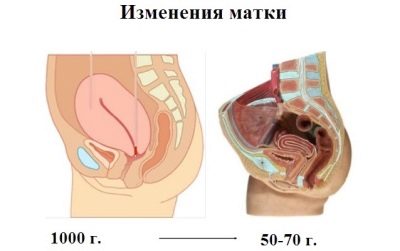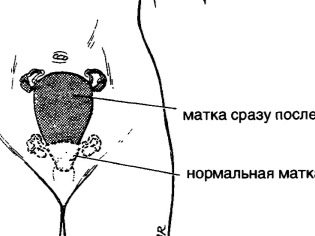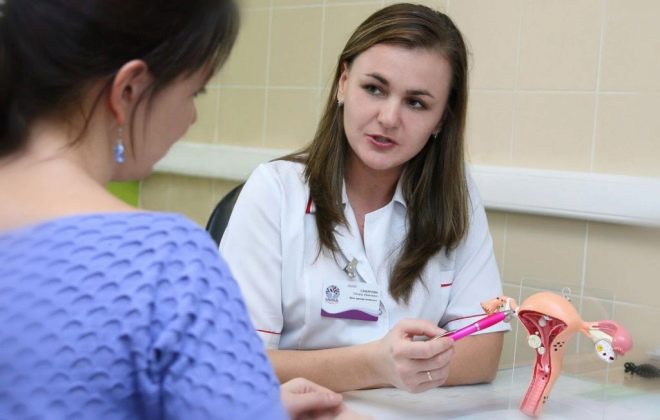Features of uterine contraction after childbirth
Immediately after the baby leaves the uterus in labor, the process of the reverse development of the female reproductive organ begins. During pregnancy, the uterus grows almost 500 times. It is clear that it can not immediately decrease to its original size after birth.
About how the process of reverse development proceeds, what can affect it and what violations can be, we will tell in this article.
How is normal?
The process of reverse development of the reproductive organ in women after childbirth is called involution in medicine. Involution is a term that does not mean anything pathological, it is a description of the process and nothing more. The uterus completed its task - helped to bear and give birth to the child. Now her task is to return to the original parameters, restore functions, so that the woman becomes fertile again and is able to conceive, bear and give birth to the next baby.
In primiparous and heterogeneous women in time the process of involution normally lasts about 6-8 weeks. This is a complex and multi-step process. Immediately after the baby is born, the uterus weighs about a kilogram, its volume is normally within 4900-5250 ml, the length of the uterus (if measured directly by ultrasound) is about 22-25 centimeters, and in diameter it is almost 15 centimeters . The uterus is above the pelvis and, in fact, is an empty bag from which all the contents were taken.
It should be noted that before the onset of pregnancy, the female uterus has a very small volume (not more than 5 ml), and the weight of the reproductive organ is 60-70 grams. In order to reach that size again, the uterus and the entire female body have to “try”.
What happens inside the reproductive organ? The fibers of the uterine tissue (myometrium) are gradually reduced. Most this process is intensive in the first 3-4 days after birth, but then the involution does not stop. With the reduction of stretched, overgrown fibers narrowed vessels.
Their complete closure gradually occurs, and the fibers, which have become unnecessary, die off and come out in the form of lochies - bloody postpartum secretions from clots. If one part of the decidual layer is rejected during contraction, the second remains to become the basis for a new endometrial layer.
Involution starts immediately after the uterus leaves the placenta (afterbirth).
In many ways, the process is bound to change the hormonal background: a low amount of progesterone, high oxytocin in the blood of the puerperal provide contractility of the reproductive organ.
At the time of involution, the myometrium receptors, which are most sensitive specifically to oxytocin, are activated more than others.
From the day of the birth of the baby, the mother starts the countdown until the end of the involution. Every day the uterus falls by 1-1.4 centimeters, gradually, it should take the same position in the pelvis. Return to the pelvis ends 10-11 days after delivery.
The cervix closes smoothly, one day after birth, it becomes less than 5 centimeters, but remains ajar, which facilitates the exit of lochia. The inner throat of the cervix closes two weeks after childbirth, and the outer one only after two months.
After the first birth, the closed external pharynx is no longer round, but transverse, and this is the main difference between the cervix of the woman who has given birth and who has not given birth. After the second or third genera, the form of the throat is the same, only the process of involution proceeds a little slower due to the fact that the walls of the uterus and the muscles of the cervix are fairly stretched and less elastic.
Inside the uterus after birth there is a placental wound - the placenta attachment site. It is she who bleeds in the first days after childbirth, and this is precisely the main difference between lohi and menstruation. The wound heals and heals by about 4 weeks after childbirth..
After cesarean section, all processes are identical, but the situation is complicated by the presence of a scar on the body of the uterus.
Therefore, involution is somewhat delayed and can go up to 4-5 months.
The sensations that accompany involution are normally reminiscent of menstrual pain, but they are much stronger. Some women compare sensations with the onset of contractions. But such they are only in the first days, a week after the birth of the child, the process of the reverse development of the uterus becomes practically imperceptible for the woman.
What is affected?
Numerous factors affect the uterine contractility after birth: the number of births, the nature of the last birth, the age of the woman, and the possible development of postpartum complications. The hormone oxytocin, which is produced exactly in the amount necessary for the involution of the reproductive organ during breastfeeding, has a special effect. At the same time, the nipple receptors, which send "signals" to the brain, are irritated, and the production of prolactin and oxytocin is stimulated. If a woman does not breastfeed, she should be given oxytocin. in injections.
Early attachment to the breast, breastfeeding can accelerate involution. In order for the uterus to quickly contract and return to its former size, a sufficiently active motor mode is recommended without lifting weights and excessive physical exertion.
If the woman is lying all the time, the reduction will go slowly.
Subinvolution
As it is not difficult to guess from the presence of the prefix, the term means that the involution proceeds pathologically, or, more precisely, not completely or partially. Among all postpartum complications, this situation is quite common: about 2% of puerperas are faced with the fact that the uterus contracts poorly, for a long time, painful contractions, the desired size of the reproductive organ can not be achieved.
Among other types of complications of the postpartum period of subinvolution, a record place is given - up to 50% of all complications have just such a character.
Since, in most cases, poor contractile ability proceeds against the background of an inflammatory disease - endometritis, scientists have not yet decided whether to consider the subinvolution of individual pathologies or consider it only as a symptomatic sign of endometritis. The development of this state is almost always associated with impaired contractility of uterine tissue (myometrium).
But it can develop due to a variety of individual factors and by their combination. It is believed that tissue edema after delivery is affected, as well as the slower formation of collagen fibers.
After a multiple pregnancy or pregnancy with a large baby, and also if there have already been more than two births, there is a risk of a violation of the contractility of the muscle tissue due to its overstretching.
If infection has penetrated into the uterus at any stage of labor or before it, then the probability of subinvolution of the uterus increases dramatically.because the presence of infectious inflammation slows down the process of reducing the natural early postpartum tissue edema.
The reasons
In most cases, when asked why the uterus contracts badly, obstetricians answer that the infection is the cause. This refers to the inflammatory process that was provoked by viruses or pathogenic bacteria in the uterus.Despite this, infection does not always cause a weak contractile ability, endometriosis is sometimes diagnosed after delivery as a separate disease, and the processes of involution in the puerperal are not disturbed. Therefore, it was decided not to list the causes of subinvolution, but a list of predisposing factors and circumstances that increase the likelihood of an abnormal regression of the reproductive female organ after the birth process.
These situations include the following factors.
- Incomplete discharge of the placenta. In the uterus remained particles of the placenta, fragments of fetal membranes. After the birth of the placenta, obstetricians must ensure that the uterus is cleaned, but this is done manually, that is, almost to the touch. The audit of the placenta is carried out on the obstetric table, checking the presence of all the lobes and shells in the “children's place”.
If there were breaks in the placenta, then it, like puzzles, is assembled in parts. This method avoids leaving large fragments, but no one is insured from leaving small ones.
- Complications during gestation. This category of risk factors of subinvolution includes a large fetus (more than 4 kilograms at birth), polyhydramnios, multiple pregnancies, that is, factors that contribute to excessive stretching of the walls of the reproductive organ.
Aggravation of cystitis and pyelonephritis during pregnancy, especially at its very end, is also considered an unfavorable factor, since these diseases increase the likelihood of infection being carried into the uterine cavity immediately after the birth of the baby.
- Complicated childbirth. Subinvolution is most common in women who have given birth rapidly, as well as in those whose birth has been delayed.
- Body Features. It is believed that stunted women are more likely to be disturbed by a contraction of the uterus in the postpartum period than tall or medium growth.
- Genetic features. If a woman's mother or grandmother suffered sub-evolution after giving birth, then the likelihood that the same will happen to their female descendants is very high.
To others adverse factors include the presence of uterine fibroids, the age of the puerperal to 19 years and after 35 years, the inability to breastfeed in the first days after birth, as well as various individual characteristics of the structure of the uterus, for example, the incorrect location of the genital organ, the disruption of its ligamentous apparatus.
Sometimes the uterus is badly reduced in women with severe anemia, as well as having chronic diseases of the heart and blood vessels.
Kinds
In obstetrics, there are several types of violations of uterine contraction in the postpartum period. Some exist mainly on the pages of obstetric textbooks and in real life are found in isolated cases.
- True subinvolution - a rare pathology in which the uterus is poorly reduced or not reduced at all for no apparent reason (there is no inflammation, no infection, no parts of the afterbirth in it). In this group, there is a myogenic disorder, in which the absence of involution is associated with a violation of muscle elasticity, a myocirculatory disorder, in which tissue swelling slowly decreases and the circulatory grid of the reproductive organ is worse restored, as well as an endocrine disorder, in which the production of natural oxytocin in the female body is insufficient.
- Infectious subinvolution - a very common phenomenon in which the contractile ability of the reproductive organ is impaired due to bacterial or viral inflammation in the uterine cavity.
Symptoms and signs
The discharge of lochia after childbirth is normal, but normally on the fifth day they become less, the nature of the discharge changes to mucous. The subinvolution is indicated by the preservation of bright and fairly abundant lohy brownish in color over several weeks..
Also indirectly, the absence of painful cramps in the lower abdomen while breastfeeding the baby may indicate a violation of uterine contraction.
Some women notice unpleasant nagging pains almost constantly, while they do not depend on the mode of breastfeeding.
If the violation has an infectious nature (which is most likely, given the prevalence of just such a subinvolution), then the symptoms will fully correspond to the symptoms and signs of endometritis. A high temperature rises, a feeling of chill appears. If at the same time and lochia cease to be bloody, and become greenish or yellow with an unpleasant smell, they speak of purulent endometritis.
Touching the abdomen, attempts by the doctor to palpate it through the anterior abdominal wall cause pain in the puerperal, as the inflammation develops, headaches, weakness increase, nausea and heart rhythm disturbances may appear.
Diagnostics
Violation of uterine contraction at the present level of development of diagnostic medicine is usually not only easily determined, but also predicted. Even during pregnancy, among all expectant mothers, obstetrician-gynecologists distinguish women who have an increased risk of similar consequences. These are future mommies of very short stature, and those with multiple births, and those who are carrying twins or triplets, as well as those bearing large babies, suffering from high hydration and preeclampsia in late pregnancy. They are closely watched not only during the gestation period, but also in the very early postpartum period.
After the birth of the baby, it is possible to establish in the woman violations of the reduction of the reproductive organ by consulting a midwife. The doctor identifies the duration, nature and amount of postpartum discharge, assesses other symptoms characteristic of subinvolution.
To clarify and confirm the diagnosis, conduct a gynecological examination. On the chair, the size of the uterus, its irregular shape, which is unacceptable in time after birth, is detected. The cervical canal of the cervix is ajar, there may be a collection of blood clots, the cervix has a purple or purple color, it is swollen. Ultrasound shows the exact size of the uterus, as well as the thickening of its walls. If there is something foreign in the cavity of the reproductive organ, this is also confirmed by ultrasound with great accuracy.
Hysteroscopy can also help doctors. This study provides accurate answers to all questions, in addition, it is possible to take a tissue sample from the inner surface of the reproductive organ for analysis, which allows you to accurately determine the type of infectious agent. A woman is tested for urine and blood, taking a smear from the vagina on the microflora.
In severe cases, MRI of the pelvic organs may be indicated.
Treatment
Violation of uterine contraction after the birth of the baby necessarily requires treatment. Whatever the violation originally caused, sooner or later, if left untreated, it becomes infectious, and full endometritis or endomyometritis develops. If such conditions are not treated, the development of sepsis, peritonitis, septic shock, and severe uterine bleeding is not excluded.. Previously, these complications were quite common cause of death after childbirth. Now there is every opportunity not to bring the problem to a deadly danger and serious consequences, for this you need to start treatment on time.
You can help a woman in a complex. Treatment consists of medication, instrumental therapy and massage.. If a bacterial infection is detected, first of all begin to fight with it: the woman is shown antibiotics in pills, in injections - exactly how, the doctor decides based on the severity of the inflammatory process.
It is hard to say how long the treatment will last; in each case, the role of the general state of immunity of the puerperal and the particular course of her pathology play a role.
For the treatment using hormonal drugs based on oxytocin - "Oxytocin", "Methylergometrine", etc. They can improve the contractility of uterine tissues. When fragments of the placenta or fetal membranes are found in the uterus, when there are accumulations of blood clots in it that clog the cervical canal, all the foreign matter from the cavity of the reproductive organ is removed. This occurs under anesthesia by vacuum aspiration or by scraping (curettage) with obstetric instruments. This, ultimately, allows the uterus to contract completely.
To relieve pain, pain relievers are used. for relaxation of the cervix with the accumulation of clots use "no-silo" and other antispasmodics in combination with hormonal drugs to enhance the contractile abilities of the myometrium.
The treatment most often takes place in the hospital, where it is possible to constantly monitor the dynamics, do tests and, if necessary, supplement or substitute drugs in the treatment regimen, inject drugs in the form of droppers. It has proven itself in the treatment of subinvolution of the uterus gynecological massage, which allows to improve the condition of the myometrium and accelerate recovery after childbirth.
Shows bed rest. A woman should not strain too much, feel physical exertion, stress.
After the acute period of inflammation is over, physiotherapy sessions and therapeutic exercises are recommended.
The prognosis of doctors when uterus subinvolution is detected after the birth process is usually positive and favorable, since pathology is perfectly treatable. And this is a reason to stop worrying and nervous because the doctor believes that the uterus is contracting worse than necessary. The situation is unpleasant, but not critical.
To prevent problems with uterine contraction women at risk are recommended to take oxytocin during the first hours and days after delivery in injections, regardless of whether they have symptoms of weak involution or not.
Folk remedies
It should be understood that it is impossible to replace traditional treatment with folk remedies in this case.
In addition, you should not assign yourself folk remedies for yourself, because they can affect the quality of breast milk and the health of the child.
At home alternative medicine recipes can help improve the recovery of the uterus after an acute period of inflammation is left behind. There are pharmaceutical herbs based on arnica flowers, leaves and nettle roots, from which you can prepare a water tincture for ingestion.
Other herbs that help clean the uterus include yarrow, shepherd's purse, and horsetail. In addition to drinking, of these herbal remedies make baths for washing.
Women reviews
According to women, after the introduction of oxytocin, lower abdominal pain becomes more pronounced, some describe them as quite strong and unpleasant. Most mothers with uterine contractility can still be detected in the maternity hospital. For this, a control ultrasound is done for 2-3 days and only after it a decision is made whether the mother and the baby can be discharged home.
In some cases, the symptoms appear after discharge home, which is why newly mothers are advised to closely monitor the nature of the discharge and body temperature during the first 10-12 days after discharge.
If you find warning signs, you should immediately consult a doctor, and when you open the bleeding and high temperature - to call an ambulance.
According to women, after treatment there were no problems and consequences. Some took several weeks to insert vaginal suppositories with anti-inflammatory sanitizing effect. Pathology did not affect subsequent pregnancy, although there is a certain percentage of reviews indicating that women after subinvolution had problems with conception when planning a subsequent pregnancy.




























